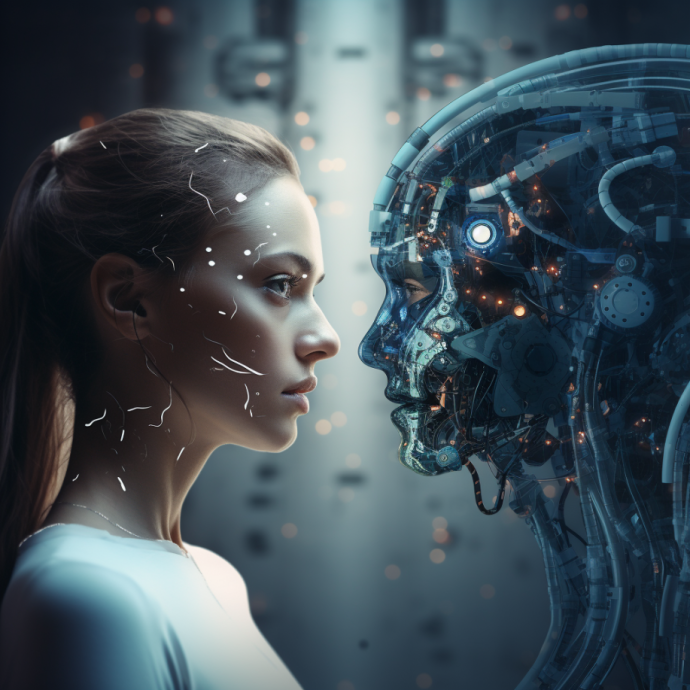Understanding Artificial Intelligence and Machine Learning: More Than Just Buzzwords

The digital age has brought forth a plethora of terminologies, with «Artificial Intelligence» (AI) and «Machine Learning» (ML) often used interchangeably. Yet, in truth, they represent different facets of the technological spectrum. Dive deep into their unique characteristics, applications, and their collective impact on the world.
Artificial Intelligence (AI): Machines with Human-like Capacities
Defining AI
At its core, AI is the science of crafting machines with abilities to perform tasks requiring human-like intelligence, such as problem-solving, decision-making, and learning. Think of it as the umbrella under which various technologies, including ML, reside. As these systems process vast data sets, they unearth patterns and insights, enabling them to perform human-like tasks more efficiently.
AI Evolution: From Fiction to Everyday Life
Beginning its journey in the 1950s, AI was once confined to sci-fi novels. Today, boosted by enhanced processing capabilities and vast data availability, it’s woven into our daily fabric—right from virtual assistants like Siri to autonomous vehicles.
Machine Learning (ML): Teaching Machines to Improve
Understanding ML
A significant subset of AI, Machine Learning, is all about algorithms that improve with experience. It is the art and science of making machines learn from data without explicit programming. By feeding them data, they adapt, predict, and function on their own.
Taxonomy of Machine Learning: Exploring Various Categories and Their Applications
Supervised Learning: In this technique, algorithms are educated using categorised information sets. The version is presented with both input and the corresponding favored output, facilitating its information of the relationships between them.
Unsupervised Learning: This method is targeted on the system's capacity to perceive underlying structures and styles inside unlabelled records. It seeks to understand inherent relationships without any pre-described categorizations.
Reinforcement Learning: Machines beneath this paradigm improve their moves based totally on non-stop comments. They perform in an environment where they examine by way of making selections, receiving rewards or consequences in go back, as a result refining their techniques through a cycle of trial and blunders.
Deep Learning: This advanced subset of gadget studying deploys synthetic neural networks, which can be stimulated by the human mind's functioning. Deep mastering excels in reading complex styles within massive and sundry information resources, often surpassing traditional techniques in accuracy and performance.
Decoding Differences: AI vs. ML
- Breadth of Field: While AI is vast, encompassing various techniques, ML zeroes in on using data to enhance machine behaviour.
- Operational Philosophy: AI mimics human intelligence, while ML seeks patterns to predict outcomes.
- Data Reliance: Traditional AI might work on small or even no data sets, but ML thrives on big data.
- Purpose Flexibility: AI algorithms are often tailor-made for specific tasks, whereas ML offers broader adaptability.
- Human Integration: AI aims to either enhance or replace human capabilities, while ML automates processes and augments human decision-making.
Navigating the Modern Landscape: The Pervasive Influence of Artificial Intelligence and Machine Learning Across Industries
As society advances into the 21st century, the effect of Artificial Intelligence (AI) and Machine Learning (ML) is transferring beyond academic discourse and theoretical frameworks to end up critical additives of diverse sectors. These technologies have proven their efficacy in tackling a large array of realistic challenges. Here, we offer an in-intensity investigate the substantial reach of AI and ML, showcasing how they've come to be critical in latest world.
Language and Communication Technologies: AI and ML algorithms are the using forces at the back of state-of-the-art chatbots that take care of customer service inquiries, advanced language translation systems that spoil down linguistic boundaries, and voice-activated structures together with Siri and Alexa, which help in each day duties.
Financial Infrastructure: These technology are revolutionizing financial control and safety by means of using algorithms to hit upon fraudulent activities, optimize stock portfolios, and even are expecting marketplace traits with increasing accuracy.
Personalized Content Delivery: Companies like Netflix and Amazon leverage machine mastering algorithms to offer tremendously tailor-made film tips and buying tips, improving person enjoy and increasing consumer engagement.
Visual and Sensory Technologies: In the purchaser electronics domain, AI is making strides through powering facial popularity functions in smartphones and safety structures. Meanwhile, drones ready with device mastering can perform duties ranging from agricultural monitoring to look and rescue operations.
Healthcare Innovations: AI and ML are at the frontline of clinical studies and patient care, helping in the whole thing from diagnostic imaging to personalized remedy plans and even the discovery of latest capsules.
The impact of AI and ML in our contemporary society demonstrates not just their technological skills however additionally their transformative capability for future innovations. As those technology continue to mature, we can expect them to come to be even extra deeply embedded in our every day routines, supplying answers that make our lives extra handy, stable, and enriched.
Influence and Impact: The AI and ML Revolution
AI and ML, while distinctive, collaboratively redefine industries. From healthcare and banking to transport, their tentacles of transformation are far-reaching. Yet, their rise prompts ethical deliberations, demanding a balance between innovation and societal harmony.
By understanding their nuances, potentials, and implications, we can better navigate the digital future shaped by AI and ML.

Become a part of digital history




Comments about Understanding Artificial Intelligence and Machine Learning: More Than Just Buzzwords